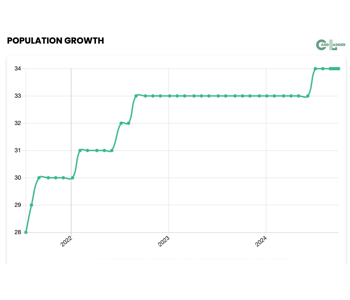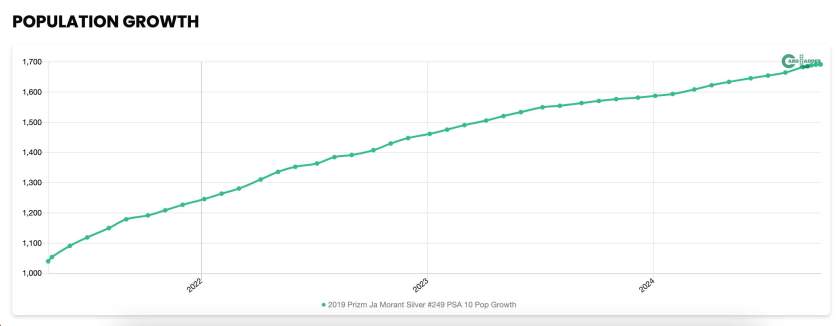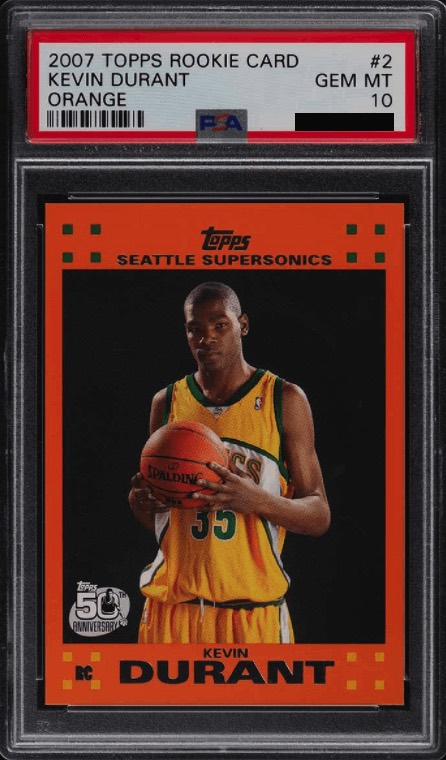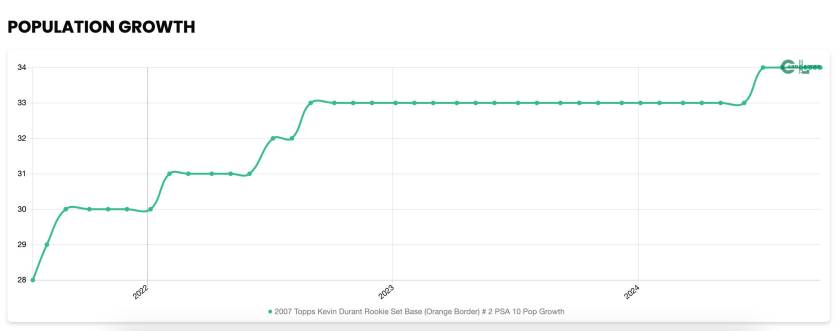
Affiliate Disclosure: Whenever you click on hyperlinks at Solely Greats & make a purchase order, we could earn a fee. As a free website, we be a part of associates like eBay & Amazon to assist offset our prices. THANK YOU in your assist!
Final Up to date On: September thirtieth, 2024
By and enormous, essentially the most helpful playing cards on the block are typically those with serial numbers. Why? As a result of that serial quantity serves as a transparent marker of simply how a lot provide of a given card exists available in the market.
However what about non-serial numbered playing cards? In any case, a few of the hottest playing cards to hit the market during the last half-decade have been non-numbered, like Panini’s iconic Silver Prizm. To that finish, we’ve got one vital instrument at our disposal to find out a card’s shortage: inhabitants development over time.
Think about this publish a crash course into inhabitants development: what it’s, easy methods to calculate it, and the extent to which pop development ought to determine into your determination to buy a card. In the end, we’ll counsel two strategies to judge a card’s inhabitants development.
Let’s dive in!
What’s Inhabitants Development?
Inhabitants refers back to the variety of playing cards which have acquired a grade. Inhabitants development is a metric that measures how a card’s inhabitants has modified over time. Sometimes this determine goes in a single course: up.
How Does Pop Development Have an effect on Card Values?
The rationale we care about inhabitants development stems from conventional guidelines about provide and demand. For the uninitiated, as provide will increase, costs are inclined to to fall (and vice-versa). This tracks with what we learn about sports activities playing cards typically; numbered playing cards are prized over non-numbered ones as a result of we’ve got a assure of a card’s manufacturing, and potential provide.
This places us in a pickle with regards to non-numbered playing cards. In any case, the full variety of playing cards printed is unknown and guarded by the manufacturers. Within the instances of a non-numbered card, inhabitants development serves as a key indicator of its shortage and, by extension, its worth.
As one would possibly surmise, a decrease inhabitants depend (or pop depend) typically means a card will maintain extra worth.
That’s not an end-all, be-all rule, nevertheless. Inhabitants development doesn’t seize demand. As an illustration, a card would possibly carry a low pop depend, however rise out of the blue and sharply. This doesn’t imply the cardboard itself is in demand, however slightly collectors are speculating that the cardboard will be in demand and price extra graded than ungraded.
The one downside: such excessive inhabitants development tends to tank a card’s worth. It’s a double-edged sword: the pastime clearly acknowledges that playing cards should be graded with a view to safe essentially the most worth potential. But such staggering inhabitants development dangers devaluing the cardboard itself.
Probably the most frequent latest instance of this impact taking part in out is with Panini basketball playing cards. Sometimes, collectors will hunt for the most-hyped gamers in a given draft and shortly ship them in for grading.
Living proof: some 330,000 Victor Wembanyama playing cards have been graded within the final yr, when the French phenom entered the NBA. Many different stars – Luka Doncic, Trae Younger, Zion Williamson – noticed their playing cards undergo the same course of. As printing strategies enhance and collectors clever as much as which playing cards will seemingly maintain worth, the variety of Gem Mint playing cards additionally tends to extend, slicing into the prized shortage that retains values excessive.
The highest-end, uber-collectible playing cards are seemingly capable of face up to no less than a few of this unimaginable inhabitants development. However for the lesser-loved playing cards, like a few of the extra vomitous Panini parallels, inhabitants development like this can inevitably place a ceiling on values. Think about this: these 330,000+ Wembanyama playing cards aren’t all the playing cards on the market, solely those which have acquired a grade. The truth that over 1 / 4 of 1,000,000 Wembanyama playing cards have been printed in any respect would possibly counsel we’re on the verge of a second Junk Wax Era.
Let’s see how a card’s excessive pop development can damage its general worth utilizing Ja Morant’s 2019 Silver Prizm PSA 10.

The cardboard’s inhabitants development is over 60% during the last three-and-a-half years. What’s extra, this price has been regular, which means there’s no cause to assume it received’t proceed climbing transferring ahead. If we look at the cardboard’s gross sales historical past, we see it trending in precisely the wrong way: down.

That’s to not say the complete gross sales worth decline is because of inhabitants development. Morant has endured loads of off-court drama all through his younger profession, which can be seemingly hurting his card costs. However there’s little doubt that the dearth of shortage is hampering his gross sales costs. Within the case of the Morant card, collectors ought to proceed with warning, given such inhabitants development.
2 Methods to Confirm Pop Development
There are two ways in which we advocate to examine pop development: Card Ladder and Gem Fee. Remember that these, and most different sources, solely monitor grades given by the 4 most distinguished graders: PSA, BGS, SGC, and CGC. Ergo, one received’t discover graders like TAG or Edge within the bunch.
Moreover, collectors can seek the advice of particular person grading corporations to trace pop development. However this isn’t a whole image; PSA will supply a card’s PSA pop depend, however not BGS or SGC. Moreover, these corporations not often present inhabitants development figures, additional limiting their effectiveness.
Card Ladder
Lengthy-time readers shouldn’t be shocked to see Card Ladder on this checklist; in spite of everything, we depend on them for many of our quantity crunching, and for good cause. It’s fast and simple to examine pop development for any card within the website’s database.
Let’s look at the method of checking a card’s inhabitants development utilizing Card Ladder with considered one of my favourite playing cards: the 2007 Topps Kevin Durant #2 Orange parallel.

To start with, let’s set the grade at a PSA 10. Card Ladder will present pop counts for every grade, however solely inhabitants development charts for one particular person grade at a time.

As soon as we’ve set our grade, we wish to navigate over to the “Pop” quantity on the cardboard’s dashboard. Click on the open ebook icon.

From there, we’ll be confronted with the cardboard’s “Inhabitants Report” web page. On the high, we’ll see a card’s whole inhabitants (throughout all graders), the full variety of gems (throughout all graders) and a card’s gem price (throughout all graders). If we scroll down, we’ll see these figures damaged up throughout obtainable graders, together with approximate card values for every grade.

Lastly, all the way in which down on the backside, we’ll discover a card’s Inhabitants Development chart for the cardboard (and particular grade) we chosen. Within the case of this Kevin Durant card, we are able to see that it’s had a 21% improve in inhabitants during the last three-and-a-half years (six Gem Mint playing cards had been added in that point, so we divide that by the unique 28 to reach at 21.4% development). Sometimes, this type of inhabitants development could be regarding; nevertheless, because the baseline figures are so low, such a rise isn’t more likely to damage the cardboard’s worth.
Gem Fee
Along with Card Ladder, Gem Rate is one other glorious useful resource for collectors. Not solely does Gem Fee present inhabitants development information for particular person playing cards, however collectors can make the most of the location to seek for particular person gamers, as nicely.

Let’s run the identical simulation utilizing the identical Orange Durant card as above. First, find the “Participant Information” tab throughout the highest banner of Gem Fee. Then, seek for a given participant, on this case, Kevin Durant.
From there, Gem Fee gives the full variety of playing cards graded, the variety of Gem Mints, and the general gem price for a given participant. To get extra particular, seek the advice of the desk of particular person playing cards. Since we wish the Orange variation, we’ll choose that possibility. To tug up a chart of the cardboard’s inhabitants development, click on the forecast arrow within the “Pattern” column.

And presto! Now we have our inhabitants development chart. Discover the darkish inexperienced line on the very backside depicts 34 PSA 10 Gem Mint grades, which represents a 1.5% gem price in opposition to 2,213 playing cards graded.

Gem Fee can be extraordinarily helpful to establish underrated playing cards primarily based on inhabitants development. Think about the 1995 Fleer Michael Jordan Whole-D insert we coated in a recent discussion on undervalued Jordan playing cards. Right here’s the chart:

Similar to the Durant above, see how the road for gem price is inverted to that of inhabitants development? That’s precisely what we’d wish to see when attempting to find underrated playing cards. What this chart is telling collectors is that, sure, this card remains to be seeing inhabitants development, however, crucially, the gem price is shrinking. In different phrases, Fleer Whole-D inserts which have acquired a Gem Mint grade stay uncommon, even within the face of inhabitants development.
Conclusion
The subsequent time you contemplate a serious card buy, be sure you try a card’s inhabitants development earlier than submitting a bid. That is particularly vital in case your intent is to flip a card; the very last thing you need is to pay a premium for a low-pop card solely to see it explode earlier than you resell.
Within the case of older playing cards, it’s truthful to imagine the grading burst is nicely behind us and never more likely to change in any vital method sooner or later. For newer (particularly basketball) playing cards, one can not assume that that is the case.
Time will inform whether or not we’re coming into a renewed Junk Wax Period. What we are able to say for positive is that monitoring inhabitants development is a wonderful strategy to be sure to’re buying playing cards that may face up to extreme print runs and inevitable market saturation.
Associated
Trending Merchandise










